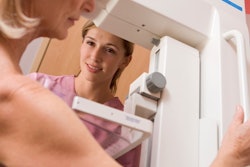
A new evaluation of the Moroccan Breast Cancer Screening Program has found the scheme continues to come up short in terms of the cancer detection rate, even though the rate of annual screening coverage achieved was acceptable.
A team led by Dr. Partha Basu, PhD, group head of the Screening Group, Early Detection and Prevention Section of the International Agency for Research on Cancer (IARC) in Lyon, France, interviewed managers, held focus groups, and randomly selected sites to determine how well the Moroccan breast screening program performed. The team found that more than 60% of the annual target population was screened, but the cancer detection rate was 1 in 1,000 women, which is lower than average (International Journal of Cancer, 14 July 2018).
Morocco doesn't use mammography for cancer screening, and like some other less developed nations with a growing breast cancer burden, the country uses clinical breast exam-based screening through routine health services. Mammography screening is too complex, resource-intensive, not feasible to implement, and unaffordable for the country, noted the researchers, who think their study has implications for other nations in similar situations.
"This [research paper] shows how a systematic program evaluation can identify the gaps and create the opportunity to implement corrective measures for improving the program outcomes," Basu and colleagues wrote. "The experience will be useful for other developing countries implementing clinical breast exam-based breast cancer screening programs."
Grading Morocco
Morocco rolled out its breast cancer screening program in 2010 for women between the ages of 40 and 69. The mean age at diagnosis is 49.5 -- approximately 10 years earlier than that reported in the Western world. The target age for the biennial screening program was 45 to 69 initially, but the protocol was revised in 2016 to lower the age at screening initiation to 40.
Trained nurses, midwives, and general practitioners perform clinical breast exams at primary health centers and refer the screen-positive women to the nearest cancer early detection center (CEDC) for further assessment. Totaling 27 across the country, the CEDCs are the diagnostic centers equipped with facilities for surgical consultation, digital mammography, breast ultrasound, core biopsy, and fine-needle aspiration cytology.
In 2017, the IARC in collaboration with the Moroccan Ministry of Health and Lalla Salma Foundation for Cancer Prevention and Treatment comprehensively evaluated the program. Basu's group looked into the program policy, protocol and financing, community mobilization efforts, quality and performance of the screening and the diagnostic services, referral mechanisms, training of service providers, and the current practices on program monitoring and coordination.
The researchers conducted in-depth interviews of program managers; held focus group discussions with service providers of screening, diagnosis, and treatment; visited randomly selected primary health centers and diagnostic centers; reviewed the national guidelines and other published documents; and analyzed the performance data compiled by the program in charge. All records were kept on paper.
They found the program has strong political support, well-organized management structure, and documented national policy and protocol. In absence of a mechanism to identify and invite the eligible women individually, the program is opportunistic in nature. Every primary health center is provided with an annual target to be screened.
In 2015 and 2016, 1.1 million and 1.5 million women, respectively, were screened. In the year 2015, 62.8% of the annual target population was covered, which reached the acceptable standard of 60%. The clinical breast exam positivity was 3.2% in 2015 and increased to 5.2% in 2016 due to lowering the target age to 40. However, both the values were substantially lower than acceptable (10% to 13% is the acceptable range).
With clinical breast examination "being a subjective test, the positivity is often high when the newly trained providers initiate screening," Basu and colleagues wrote. "Taking cognizance of the consistent and robust data obtained from the program over several years, the national experts need to review the standards. [Clinical breast exam] positivity should be regularly monitored across the [primary health centers] and either too high or low values would necessitate retraining of the service providers."
Further assessment rate of screen-positive women was 34.1%, and the breast cancer detection rate was 1 in 1,000 women, which is low, they continued. The detection rate reported in mammography-based screening programs in Europe is 5.9 out of 1,000 women, and the cancer detection rate for clinical breast exam screening programs in the U.S. is 5 out of 1,000 women.
| Breast cancer detection rate for top 5 regions in Morocco | |||
| Region | No. of women screened | No. of breast cancers detected at CEDC | Breast cancer detection rates (1/1,000) |
| Tangier-Tétouan | 107,849 | 193 | 1.8 |
| Rabat-Salé-Zemmour-Zaer | 75,733 | 175 | 2.3 |
| Meknès-Tafilalet | 61,629 | 87 | 1.4 |
| Grand Casablanca | 163,461 | 214 | 1.3 |
| Gharb-Chrarda-Béni Hssen | 48,169 | 88 | 1.8 |
The rate can partially be explained by the difference in disease prevalence -- the detection rate in Morocco was comparable to that reported in a large breast cancer screening study using annual clinical breast exam among 896,596 women between 40 to 69 years old in Taiwan.
"It is possible that the opportunistic program is screening a proportionately higher number of younger women, and the elderly women with much higher risk of breast cancer are being left out," the authors wrote. "The detection rate of breast cancer in Morocco could also be influenced by the noncompliance of the [clinical breast exam]-positive women to further assessment, which was not possible to measure."
Implications for other countries
The evaluation of the national breast cancer screening program in Morocco demonstrates the real-world perspective on clinical breast exam practice and is feasible in many developing countries that have introduced screening but do not have a well-functioning health information system, according to Basu and colleagues.
"The Moroccan experience also highlights that effective program leadership, a written standard operating procedure of data collection for program monitoring, appropriate coordination between different service delivery settings, meticulous maintenance of paper-based records, and orientation of the service providers to the importance of proper record-keeping can help collect performance data even in absence of a computerized information system from a mass-scale screening program in a developing country," they noted.
However, data collection by itself is not enough to ensure improvement in the quality of the program.
"The performance of the program in terms of inputs and outcomes should be monitored and evaluated, and specific actions need to be taken to fill in the gaps identified during evaluation," the authors added.
The gaps include the program's visibility as well as the necessity for further training. Some primary health centers screen very few women per month and it is difficult to maintain clinical breast exam skills. A structured training plan could help with that endeavor by ensuring adequate training and certified providers.
Also, lowering the age of the target population may reduce the screening test's positive predictive value and the breast cancer detection rate. This could reduce the program's efficiency and increase the cost.
"The extension of screening to the younger age should be reviewed by assessing the detection rates stratified by the age groups," Basu and colleagues wrote. "The program needs to collect the age of the screen-detected cancers to perform such analysis."
Setting up computerized information systems at the CEDCs and linking them at least with the major oncology centers could help the cancer-tracking process. The oncology centers could share the breast cancer data with the program on regular basis and could ensure adherence to the screening protocols.
The breast screening program should also collect data from the major oncology centers and the population-based cancer registries to document the proportion of breast cancers being detected through the program and to document the stage shift achieved through screening.
The IARC and Lalla Salma Foundation for Cancer Prevention and Treatment initiated a prospective collaborative study to compare the stage distribution, quality of life, and survival between the screen-detected and the self-reported breast cancer patients at the major oncology centers in Morocco. The study will provide valuable information on the benefit of the screening program.
The Moroccan Ministry of Health has already taken necessary steps to introduce the computerized database at the CEDCs and review the training plan, according to the researchers.



















